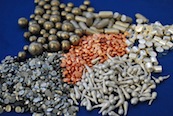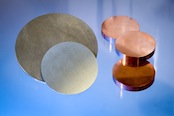Tantalum Fluoride
MATERIAL SAFETY DATA SHEET
I. PRODUCT IDENTIFICATION
Manufacturer/Supplier:
ESPI Metals
1050 Benson Way, Ashland, OR 97520
Toll Free (800) 638-2581 * Fax (541) 488-8313
E-Mail: This email address is being protected from spambots. You need JavaScript enabled to view it.
Product Name: Tantalum Fluoride
Synonym: Tantalum (V) Fluoride
Formula: TaF5
CAS Number: 7783-71-3
II. HAZARDOUS INGREDIENTS
Hazardous Component: Tantalum Fluoride
Percent (%): 0-100
OSHA/PEL: 2.5 mg(F)/m3
ACGIH/TLV: 2.5 mg(F)/m3
HMIS Ratings:
Health: 4
Flammability: 0
Reactivity: 1
III. PHYSICAL DATA
Boiling Point: 229.5 oC
Melting Point: 96.8 oC
Specific Gravity: 4.74 g/cc
Solubility in H2O: Soluble
Appearance and Odor: Colorless, deliquescent powder and pieces, no odor.
IV. FIRE AND EXPLOSION HAZARDS DATA
Flash Point: N/A
Method Used: Non-flammable
Explosive Limits: Lower: N/A Upper: N/A
Autoignition Temperature: No data
Extinguishing Media: Use suitable extinguishing media for surrounding materials and type of fire.
Special Fire Fighting Procedures: Firefighters must wear full face self-contained breathing apparatus with full protective clothing to prevent contact with skin and eyes. Fumes from fire are hazardous. Isolate runoff to prevent environmental pollution.
Unusual Fire and Explosion Hazards: When heated to decomposition, tantalum fluoride may emit toxic fumes of fluorine.
V. HEALTH HAZARD INFORMATION
Effects of Exposure:
To the best of our knowledge the chemical, physical and toxicological properties of tantalum fluoride have not been thoroughly investigated and recorded.
Tantalum compounds may cause skin and eye irritation.
Inorganic fluorides are generally highly irritating and toxic. Chronic fluorine poisoning, or “fluorosis”, occurs among miners of cryolite, and consists of sclerosis of the bones, caused by fixation of the calcium by fluorine. There may also be some calcification of the ligaments. The teeth are mottled, and there is osteosclerosis and osteomalacia. Large doses can cause very severe nausea, vomiting, diarrhea, aggravate attacks of asthma and cause severe bone changes, making normal movements painful. Some signs of pulmonary fibrosis are noted. Some enzyme system effects are reported. Irritant to the eyes, skin and mucous membranes. Loss of weight, anorexia, anemia, wasting and cachexia and dental defects are among the common findings in chronic fluorine poisoning. There may be an eosinophilia and impairment of growth in young workers. Symptoms of intoxication include gastric, intestinal, circulatory, respiratory and nervous complaints and rashes. (Sax, Dangerous Properties of Industrial Materials)
Acute Effects:
Inhalation: SEVERE IRRITANT AND CORROSIVE to the respiratory tract and mucous membranes. May cause asthma attacks, excessive salivation, thirst, sweating, vomiting, colic, diarrhea and lung granulomas.
Ingestion: SEVERE IRRITANT AND CORROSIVE. May cause gastrointestinal irritation, nausea, vomiting, diarrhea and cramp-like pains.
Skin: SEVERE IRRITANT AND CORROSIVE. May cause rashes and skin granulomas.
Eye: SEVERE IRRITANT AND CORROSIVE.
Chronic Effects:
Inhalation: May cause fluorosis, pulmonary fibrosis and severe bone changes.
Ingestion: May affect the circulatory, enzyme and nervous system.
Skin: Severe irritant and corrosive.
Eye: Severe irritant and corrosive.
Target Organs: May affect the skeleton, kidneys, central nervous system, respiratory system, eyes and skin.
Medical Conditions Generally Aggravated by Exposure: Can cause or aggravate attacks of asthma.
Carcinogenicity: NTP: No IARC: No OSHA: No
EMERGENCY AND FIRST AID PROCEDURES:
INHALATION: Remove victim to fresh air, keep warm and quiet, give oxygen if breathing is difficult and seek medical attention immediately.
INGESTION: Do not induce vomiting, seek medical attention immediately.
SKIN: Remove contaminated clothing from affected area, brush material off skin, wash affected area with mild soap and water, seek medical attention immediately.
EYE: Flush eyes with lukewarm water, lifting upper and lower eyelids, for at least 15 minutes. Seek medical attention immediately.
VI. REACTIVITY DATA
Stability: Stable
Conditions to Avoid: None
Incompatibility (Material to Avoid): None recorded
Hazardous Decomposition Products: Fumes of fluorine.
Hazardous Polymerization: Will not occur
VII. SPILL OR LEAK PROCEDURES
Steps to Be Taken in Case Material Is Released or Spilled: Wear appropriate respiratory and protective equipment specified in section VIII. Isolate spill area and provide ventilation. Vacuum up spill using a high efficiency particulate absolute (HEPA) air filter and place in a closed container for proper disposal. Take care not to raise dust.
Waste Disposal Method: Dispose of in accordance with all State, Federal and Local regulations.
VIII. SPECIAL PROTECTION INFORMATION
Respiratory Protection (Specify Type): NIOSH approved dust-mist-vapor respirator.
Ventilation: Use local exhaust to maintain concentration at low exposure levels. Handle in a controlled atmosphere in an inert gas such as argon. General exhaust is not recommended.
Protective Gloves: Rubber, butyl, neoprene gloves
Eye Protection: Safety glasses
Other Protective Clothing or Equipment: Protective gear suitable to prevent contamination.
IX. SPECIAL PRECAUTIONS
Precautions to Be Taken in Handling and Storage: Store in a cool, dry area in a tightly sealed container. Wash thoroughly after handling. Do not store together with acids.
Other Precautions: Tantalum fluoride is deliquescent. Handle and store in a controlled environment and inert gas such as argon.
Work Practices: Implement engineering and work practice controls to reduce and maintain concentration of exposure at low levels. Use good housekeeping and sanitation practices. Do not use tobacco or food in work area. Wash thoroughly before eating and smoking. Do not blow dust off clothing or skin with compressed air. Maintain eyewash capable of sustained flushing, safety drench shower and facilities for washing.
The above information is believed to be correct, but does not purport to be all inclusive and shall be used only as a guide. ESPI shall not be held liable for any damage resulting from handling or from contact with the above product.
Issued by: S. Dierks
Date: March 2005

 ALLOYS
ALLOYS 





